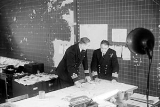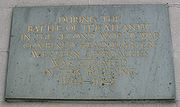
Western Approaches Command
Encyclopedia
Commander-in-Chief, Western Approaches was the commander of a major operational command of the Royal Navy
during World War II
. The admiral commanding, and his forces, sometimes informally known as 'Western Approaches Command,' were responsible for the safety of British shipping in the Western Approaches
.
, also took over responsibility for the Western Approaches from the start of World War II
.
After the fall of France in June 1940, the main North Atlantic convoy
routes were diverted around the north of Ireland through the north-western approaches. By late 1940, the location of the Combined Operations headquarters at Plymouth was increasingly awkward and the decision was taken to move the Combined Operations headquarters to Liverpool
. On 7 February 1941, the headquarters was established at Derby House, Liverpool. The headquarters of Royal Air Force
’s No.15 Group Coastal Command moved to Liverpool at the same time. On 17 February 1941 Admiral Sir Percy Noble was appointed as the new Commander-in-Chief, Western Approaches Command.
Over the next two years, Admiral Noble built up the bases for the North Atlantic escort groups at Greenock
on the Clyde, Londonderry
and Liverpool
and set up the training facilities that were the foundations for eventual victory in the Battle of the Atlantic.
 On 19 November 1942, Admiral Noble was replaced by Admiral Max Horton
On 19 November 1942, Admiral Noble was replaced by Admiral Max Horton
, who was Commander-in-Chief from that day until Western Approaches Command closed on 15 August 1945.
Horton’s leadership played a vital role in the final defeat of the U-boat menace. Horton used the increasing number of escorts that were available to the command to organize "support groups" that were used to reinforce convoy
s that came under attack. Unlike the regular escort groups, the support groups were not directly responsible for the safety of any particular convoy. This lack of responsibility gave them much greater tactical
flexibility, allowing the support groups to detach ships to hunt submarine
s spotted by reconnaissance or picked up by high-frequency direction finding (HF/DF
). In situations where the regular escorts would have had to return to their convoy, the support groups were able to persist in hunting a submarine for many hours until it was forced to the surface.
The reinforced central core of the command bunker at Derby House, Liverpool proved too costly to demolish, and so whilst the rest of the building has been converted to modern offices, the bunker has been restored as a museum, open to the public. The museum is known as the Western Approaches - Liverpool War Museum.
Royal Navy
The Royal Navy is the naval warfare service branch of the British Armed Forces. Founded in the 16th century, it is the oldest service branch and is known as the Senior Service...
during World War II
World War II
World War II, or the Second World War , was a global conflict lasting from 1939 to 1945, involving most of the world's nations—including all of the great powers—eventually forming two opposing military alliances: the Allies and the Axis...
. The admiral commanding, and his forces, sometimes informally known as 'Western Approaches Command,' were responsible for the safety of British shipping in the Western Approaches
Western Approaches
The Western Approaches is a rectangular area of the Atlantic ocean lying on the western coast of Great Britain. The rectangle is higher than it is wide, the north and south boundaries defined by the north and south ends of the British Isles, the eastern boundary lying on the western coast, and the...
.
History
Admiral Martin Dunbar-Nasmith, who had been Commander-in-Chief, PlymouthCommander-in-Chief, Plymouth
The Commander-in-Chief, Plymouth was a senior commander of the Royal Navy for hundreds of years. Plymouth Command was a name given to the units, establishments, and staff operating under the admiral's command. In the nineteenth century the holder of the office was known as Commander-in-Chief,...
, also took over responsibility for the Western Approaches from the start of World War II
World War II
World War II, or the Second World War , was a global conflict lasting from 1939 to 1945, involving most of the world's nations—including all of the great powers—eventually forming two opposing military alliances: the Allies and the Axis...
.
After the fall of France in June 1940, the main North Atlantic convoy
Convoy
A convoy is a group of vehicles, typically motor vehicles or ships, traveling together for mutual support and protection. Often, a convoy is organized with armed defensive support, though it may also be used in a non-military sense, for example when driving through remote areas.-Age of Sail:Naval...
routes were diverted around the north of Ireland through the north-western approaches. By late 1940, the location of the Combined Operations headquarters at Plymouth was increasingly awkward and the decision was taken to move the Combined Operations headquarters to Liverpool
Liverpool
Liverpool is a city and metropolitan borough of Merseyside, England, along the eastern side of the Mersey Estuary. It was founded as a borough in 1207 and was granted city status in 1880...
. On 7 February 1941, the headquarters was established at Derby House, Liverpool. The headquarters of Royal Air Force
Royal Air Force
The Royal Air Force is the aerial warfare service branch of the British Armed Forces. Formed on 1 April 1918, it is the oldest independent air force in the world...
’s No.15 Group Coastal Command moved to Liverpool at the same time. On 17 February 1941 Admiral Sir Percy Noble was appointed as the new Commander-in-Chief, Western Approaches Command.
Over the next two years, Admiral Noble built up the bases for the North Atlantic escort groups at Greenock
Greenock
Greenock is a town and administrative centre in the Inverclyde council area in United Kingdom, and a former burgh within the historic county of Renfrewshire, located in the west central Lowlands of Scotland...
on the Clyde, Londonderry
Derry
Derry or Londonderry is the second-biggest city in Northern Ireland and the fourth-biggest city on the island of Ireland. The name Derry is an anglicisation of the Irish name Doire or Doire Cholmcille meaning "oak-wood of Colmcille"...
and Liverpool
Liverpool
Liverpool is a city and metropolitan borough of Merseyside, England, along the eastern side of the Mersey Estuary. It was founded as a borough in 1207 and was granted city status in 1880...
and set up the training facilities that were the foundations for eventual victory in the Battle of the Atlantic.

Max Kennedy Horton
Admiral Sir Max Kennedy Horton, GCB, DSO and two bars was a British submariner in World War I and commander-in-chief of the Western Approaches in the latter half of World War II, responsible for British participation in the Second World War's Battle of the Atlantic.-First World War:Horton joined...
, who was Commander-in-Chief from that day until Western Approaches Command closed on 15 August 1945.
Horton’s leadership played a vital role in the final defeat of the U-boat menace. Horton used the increasing number of escorts that were available to the command to organize "support groups" that were used to reinforce convoy
Convoy
A convoy is a group of vehicles, typically motor vehicles or ships, traveling together for mutual support and protection. Often, a convoy is organized with armed defensive support, though it may also be used in a non-military sense, for example when driving through remote areas.-Age of Sail:Naval...
s that came under attack. Unlike the regular escort groups, the support groups were not directly responsible for the safety of any particular convoy. This lack of responsibility gave them much greater tactical
Naval tactics in the Age of Steam
The development of the steam ironclad firing explosive shells in the mid 19th century rendered sailing tactics obsolete. New tactics were developed for the big-gun Dreadnought battleships. The mine, torpedo, submarine and aircraft posed new threats, each of which had to be countered, leading to...
flexibility, allowing the support groups to detach ships to hunt submarine
Submarine
A submarine is a watercraft capable of independent operation below the surface of the water. It differs from a submersible, which has more limited underwater capability...
s spotted by reconnaissance or picked up by high-frequency direction finding (HF/DF
Huff-Duff
High-frequency direction finding, usually known by its abbreviation HF/DF is the common name for a type of radio direction finding employed especially during the two World Wars....
). In situations where the regular escorts would have had to return to their convoy, the support groups were able to persist in hunting a submarine for many hours until it was forced to the surface.
The reinforced central core of the command bunker at Derby House, Liverpool proved too costly to demolish, and so whilst the rest of the building has been converted to modern offices, the bunker has been restored as a museum, open to the public. The museum is known as the Western Approaches - Liverpool War Museum.
Commanders-in-Chief, Western Approaches
Commanders-in-Chief included:| Rank | Name | Term began | Term ended | |
|---|---|---|---|---|
| Commander-in-Chief, Western Approaches | ||||
| Admiral | Martin Dunbar-Nasmith | 9 September 1939 | 17 February 1941 | |
| Admiral | Sir Percy Noble | 17 February 1941 | 19 November 1942 | |
| Admiral | Max Horton Max Kennedy Horton Admiral Sir Max Kennedy Horton, GCB, DSO and two bars was a British submariner in World War I and commander-in-chief of the Western Approaches in the latter half of World War II, responsible for British participation in the Second World War's Battle of the Atlantic.-First World War:Horton joined... |
19 November 1942 | 15 August 1945 | |
See also
- Anti-submarine warfareAnti-submarine warfareAnti-submarine warfare is a branch of naval warfare that uses surface warships, aircraft, or other submarines to find, track and deter, damage or destroy enemy submarines....
- U-boatU-boatU-boat is the anglicized version of the German word U-Boot , itself an abbreviation of Unterseeboot , and refers to military submarines operated by Germany, particularly in World War I and World War II...
- Battle of the Atlantic (1939-1945)
- Secret Services. Description of Western Approaches Command Centre. www.historyarticles.com
External links
- Western Approaches - Liverpool War Museum - official site

